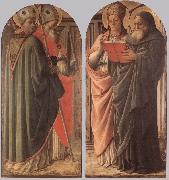|
|
|
|
|
LIPPI, Fra Filippo
|
|
Disputation_in_the_Synagogue_(detail)_sd
|
|
1452-65
Fresco
Duomo,_Prato
|
|
|
|
|
|

|
|
Click to Enlarge
|
| LIPPI,_Fra_Filippo
|
Disputation in the Synagogue (detail) sd
LIPPI, Fra Filippo5.jpg
|
|
|
|
|
|
| 1452-65
Fresco
Duomo, Prato |
|
|
Italian Early Renaissance Painter, ca.1406-1469
Filippo Lippi was born in Florence. He took his vows in 1421 in the monastery S. Maria del Carmine, where Masaccio frescoed the Brancacci Chapel in the church (1426-1427). By 1430 Lippi is mentioned in church documents as "painter." Masaccio's influence, as well as Donatello's, can be seen in Lippi's early works, such as the Tarquinia Madonna of 1437 (National Gallery, Rome) and the Annunciation (S. Lorenzo, Florence) and Barbadori Altar (Louvre, Paris), both begun in 1437/1438. However, the severity of Masaccio and Donatello was mitigated by Lippi, who was instrumental in salvaging from the Gothic past the lyrical expressiveness of a linear mode which Masaccio had all but given up for modeling in chiaroscuro. Toward the middle of the 15th century Lippi's pictures became more finely articulated and his surface design more complex. It is probable that he had a large workshop, and the hand of assistants may be observed in the important fresco decoration started in 1452 in the choir chapel of the Prato Cathedral. After delays and strong protests this commission was finally completed in 1466. The cycle, a highly important monument of Early Renaissance painting, demonstrates Lippi's increasingly more mature style, revealing him to be witty, original, and well versed in all the artistic accomplishments of his time, to which he himself contributed. Through linear perspective Lippi was able to render a convincing illusion of recession and plausible three-dimensional figures. He knew how to express emotions, and he was a keen observer of nature. Lippi painted astonishing portrait likenesses and combined figures and space with an animated surface rhythm, the best example of which can be seen in the Feast of Herod, one of the last scenes in the Prato cycle. During his stay at Prato he was the cause of a scandal (later resolved by papal indulgence): he ran off with a nun, Lucrezia Buti, who bore him two children, one of whom, Filippino Lippi (ca. 1457-1504), was also a painter. In the Prato frescoes as well as in his contemporary panel pictures, such as the Madonna with Two Angels (Uffizi Gallery, Florence), or in the exquisite tondo of the Madonna (Pitti Palace, Florence), Filippo Lippi anticipated later developments in 15th-century painting. In these pictures are to be found the sources of Sandro Botticelli, Lippi's most illustrious pupil. Lippi's innovations extended also to iconography. In his quest for realism he introduced the "bourgeoise" Madonna: the type of contemporary Florentine lady elegantly dressed in the fashion of the time with the hair on her forehead plucked to stress the height of it. He also introduced the subject of the Madonna adoring the Child in the woods (Museum of Berlin, and Uffizi, Florence).
|
|
|
|
|
|
|